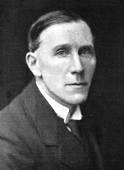J. D. Beresford
J. D. Beresford | |
|---|---|
 | |
| Born | John Davys Beresford 17 March 1873 |
| Died | 1 February 1947 (aged 73) |
| Genre | Science fiction, horror, ghost stories |
| Children | Elisabeth Beresford |
John Davys Beresford (17 March 1873 – 1 February 1947) was an English writer, now remembered for his early science fiction and some short stories in the horror story and ghost story genres. Beresford was a great admirer of H. G. Wells, and wrote the first critical study of Wells in 1915. [1] His Wellsian novel The Hampdenshire Wonder was a major influence on Olaf Stapledon. [2] His other science-fiction novels include The Riddle of the Tower, about a dystopian, hive-like society. [3]
His father was a clergyman in Castor, now in Cambridgeshire near Peterborough. J. D. Beresford was affected by infantile paralysis, which left him partially disabled. [4][5] He was educated at Oundle.
After training to become an architect, he became a professional writer, first as a dramatist, and journalist. In early adulthood he broke away from his father's views and became a "determined but defensive" agnostic.[6] He combined a prominent place in Edwardian literary London with time spent in the provinces, in particular Cornwall where D. H. Lawrence had an extended stay in his Porthcothan cottage. Later in life Beresford abandoned his earlier agnosticism and described himself as a Theosophist and a pacifist.[4]
Beresford also contributed to numerous publications; in addition to being a book reviewer for The Manchester Guardian, he also wrote for the New Statesman, [7] The Spectator, Westminster Gazette,and the Theosophist magazine The Aryan Path. [8] At one point, Beresford was offered the editorship of the pacifist magazine Peace News but declined because he felt he "would be a bad editor". [9]
Beresford's interest in the spiritual and philosophical may be best illustrated by the publisher notes to his novel, On A Huge Hill:
"Mr Beresford's readers have long known that that for him there are more things in heaven or earth than are dreamt of in official medical philosophy. He has used his novelist's skill to convince the sensitive reader that the age of miracles is not over, and that, in certain circumstances, the spirit may exercise what seem to us miraculous powers over the substance of the body. This he did in 'The Camberwell Miracle' and 'Peckover'; and in this absorbing novel, he returns to the theme, with the study of a man fitting himself to become a great healer."
Elisabeth Beresford (1926–2010), children's writer and creator of The Wombles, was his daughter. Through his son, writer Marc Brandel, he is the great-grandfather of American actor James Newman.
Works
- The Early History of Jacob Stahl (1911) trilogy of novels includes A Candidate for Truth and The Invisible Event
- The Hampdenshire Wonder (1911) novel
- A Candidate for Truth (1912)
- Goslings: A World of Women (1913) novel
- The House in Demetrius Road (1914) novel
- The Invisible Event (1915) novel
- H. G. Wells (1915) criticism
- These Lynneskers (1916) Novel
- William Elphinstone Ford (1917) biography, with Kenneth Richmond
- House Mates (1917) Novel
- Nineteen Impressions (1918) stories
- God's Counterpoint (1918)Novel
- The Jervaise Comedy (1919)Novel
- The Imperfect Mother (1920) Novel
- Signs and Wonders (1921, Golden Cockerel Press) stories
- Revolution (1921) novel
- The Prisoner of Hartling (1922) Novel
- The Imperturbable Duchess and Other Stories (1923)
- Monkey Puzzle (1925)
- That Kind of Man, or Almost Pagan (1926)Novel
- The Instrument of Destiny (1928) a mystery novel
- All or Nothing (1928) novel
- Real People (1929) novel
- The Meeting Place and Other Stories (1929)
- Love's Illusion (1930)
- The Next Generation (1932) novel
- The Old People (1932) Novel
- The Camberwell Miracle (1933) novel
- Peckover (1934) novel
- On a Huge Hill (1935) novel
- Blackthorn Winter and other stories (1936)
- The Decoy (1937) Novel
- Cleo (1937) Novel
- What Dreams May Come (1941) novel
- A Common Enemy (1941) novel
- Men in the Same Boat (1943) (with Esmé Wynne-Tyson)
- The Riddle of the Tower (1944) (with Esme Wynne-Tyson)
- The Gift (1947) (with Esme Wynne-Tyson)
- The Prisoner
- Love's Pilgrim
References
- ^ Michael R. Page, The Literary Imagination from Erasmus Darwin to H. G. Wells:Science, Evolution, and Ecology Ashgate Publishing, Ltd., 2012 (p. 191) ISBN 1409438694.
- ^ Brian Stableford, The Hampdenshire Wonder in Frank N. Magill, ed. Survey of Science Fiction Literature, Vol. 2. Englewood Cliffs, NJ: Salem Press, 1979. pp. 945-949. ISBN 0-89356-194-0
- ^ Brian Stableford, The Riddle of the Tower in Frank N. Magill, ed. Survey of Science Fiction Literature, Vol. 4. Englewood Cliffs, NJ: Salem Press, 1979. pp. 1780-1783. ISBN 0-89356-194-0
- ^ a b Stanley J. Kunitz and Howard Haycraft, Twentieth Century Authors, A Biographical Dictionary of Modern Literature, (Third Edition). New York, The H.W. Wilson Company, 1950, (p.p. 130-1)
- ^ J. D. Beresford (1998) George M. Johnson, pg 2
- ^ SF Encyclopedia article
- ^ Bashir Abu-Manneh, Fiction of the New Statesman: 1913 - 1939, Lexington Books, 2011 ISBN 1611493528. (p. 37)
- ^ George M. Johnson, J. D. Beresford. Twayne Publishers, 1998 ISBN 0805770399. ( p.177)
- ^ Johnson, p. 30.
- J. D. Beresford (1998) George M. Johnson
- Bleiler, Everett (1948). The Checklist of Fantastic Literature. Chicago: Shasta Publishers. p. 49.
